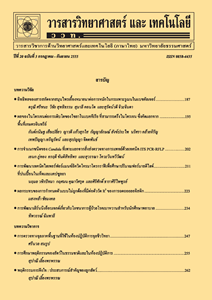สมบัติทางเคมีกายภาพของแป้งข้าวโพดบดหยาบดัดแปรด้วยกระบวนการเอกซ์ทรูชัน
Main Article Content
Abstract
Abstract
This study investigated the physicochemical properties of corn grit flour modified by co-rotating twin screw extruder. The effect of particle size (250, 500 and 600 µm), feed moisture content (14, 16 and 18 %) and screw speed (300, 350 and 400 rpm) on color, expansion ratio, bulk density, water absorption index (WAI), water solubility index (WSI) and rheological of modified extrudates was investigated. Increasing feed moisture content resulted exudates with higher bulk density, WAI and cold paste viscosity, but lower the expansion ratio and WSI. Increasing particle size caused a brighter color and higher amylose content than small particle size. The expansion ratio and WSI increased with increasing the screw speed.
Keywords: corn grit; modified starch; extrusion; physical property; chemical property
Article Details
References
[2] BeMiller, J.N., 1997, Starch modification: Challenges and prospects, Starch/Staeke 49: 127-131.
[3] Power, E.L., 1967, Production and Use of Pregelatinized Starch, pp. 523-536, In Whistler, R.L. and Paschall, E.F. (Eds.), Starch: Chemistry and Technology Vol. II, Academic Press, Inc., New York.
[4] Boettger, M., 1963, Recent study show the effect of pregelatinized starches on cake quality, Cereal Sci. Today 8: 106-108.
[5] Gardiner, D.S., 1975, Dessert Composition, British-Patent, 1 419 996.
[6] Ronai, K.S. and Spanier, H.C., 1972, Instant Oat Cereal, United-State-Patent, 3 704 134.
[7] Senda, A., 1991, Premix Preparation for Ice Foods, United-States-Patent, 5 006 359.
[8] Beltran, E.G. and Singer, N.S., 1970, Snack Food, Canadian-Patent, 847 281 (847281).
[9] Anton, A.A., Fulcher, R.G. and Arntfield, S.D., 2009, Physical and nutritional impact of fortification of corn starch-based extruded snacks with common bean (Phaseolus vulgaris L.) flour: Effects of bean addition and extrusion cooking, Food Chem. 113: 989-996.
[10] Rahman, M.S., 1995, Food Properties Handbook, CRC Press, Inc., Boca Raton, FL, 528 p.
[11] Anderson, R.A., Conway, H.F., Pfeifer, V.F. and Griffin, E.L., 1969, Gelatinization of corn grits by roll- and extrusion-cooking, Cereal Sci. Today 14: 4-12.
[12] Ding, Q.B., Ainsworth, P., Plunkett, A., Tucker, G. and Marson, H., 2006, The effect of extrusion condition on the functional and physical properties of wheat-based expanded snacks, J. Food Eng. 73: 142-148.
[13] Charunuch, C., Limsangouan, N., Prasert. W. and Wongkrajang, K., 2014, Optimi-zation of extrusion conditions for ready-to-eat breakfast cereal enhanced with defatted rice bran, Int. Food Res. J. 21: 713-722.
[14] Charunuch, C., Tangkanakul, P., Rungchang, S. and Sonted, V., 2008, Application of mulberry (Morus alba L.) for supplementing antioxidant activity in extruded Thai rice snack, Int. Kasetsart. J. (Nat. Sci.) 42: 79-87.
[15] Singh, N., Singh, B., Sandhu, K.S., Bawa, A.S. and Seknon, K.S., 1996, Extrusion behavior of wheat, rice and potato blends, J. Food Sci. Technol. 30: 291-294.
[16] Barrett, A.H. and Peleg, M., 1992, Extrudate cell structure-texture relationships, J. Food Sci. 57: 1253-1257.
[17] Pan, Z., Zhang, S. and Jane, J., 1998, Effect of extrusion variables and chemicals on the heamolysis, Phytochem. 36: 579-583.
[18] Mercier, C., Linko, P. and Harper, J.M., 1989, Extrusion Cooking. American Association of Cereal Chemists, St. Paul, Minnesota, 471 p.
[19] Stojceska, V., Ainsworth, P., Plunkett, A. and Ibanoglu, S., 2009, The effect of extrusion cooking using different water feed rates on the quality of ready-to-eat snacks made from food by-products, Food Chem. 114: 226-232.
[20] El Dash, A.A., Gonzales, R. and Ciol, M., 1983, Response surface methodology in the control of thermoplastic extrusion of starch, J. Food Eng. 2: 129-152.
[21] Paton, D. and Stratt, W.A., 1984, Component interactions in the extrusion cooking process: Influence of process conditions on the functional viscosity of the wheat flour system, J. Food Sci. 49: 1380-1385.

